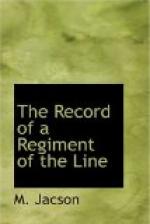The pass over Burgher’s Nek was held by the Boers under Gravett, Botha and the State treasure with a small escort having crossed only a few hours before, whilst a portion of their army under Viljoen retired at the same time to the north towards Pietersburg.
The infantry of the advance guard was composed of four companies of the Regiment under Captain Jacson. On reaching the foot of the pass the mounted troops were checked and the artillery came into action. The position occupied by the Boers was formidable—a long stretch of high rugged hills, with the forward slope ending precipitously. The pass lay over a Nek between two high shoulders of hills. The Boers, exceedingly well posted, occupied the hills on either side of the Nek, taking cover behind the immense boulders on the summit.
After the artillery had been bombarding the south side of the Nek for some considerable time, the mounted infantry were sent forward to occupy the hill known as Grass Kop, but were unable to proceed. In the meantime, the four companies of the advance guard had been moved off to the left and nearer to the hills. They now got the order to attack and occupy the hill. Whilst these companies moved off under cover of the undulating ground to the foot of the hills, two companies with the Maxim gun took up a position in rear to cover the advance, firing with a range of 1700 yards at the top of the hill. Most of the artillery came into action at the same time and at the same objective. The foot of the hill was reached by the attacking force with two casualties. One company was then directed to the left to attack round the flank, and the ascent of the precipitous side of the hill was commenced. Crawling up a goat’s track in single file, on hands and knees, through dense bush, the first portion of the ascent was accomplished, and the little force formed up under a spur to get breath before debouching into the open for the final rush to the top. After a short halt the advance was continued to the summit, the companies on their way coming under a smart shell fire from their own guns (happily without casualties), which were bursting shrapnel with wonderful precision between the two leading companies. Just before reaching the top the flanking company, coming in from the left with a well-timed advance, joined the general advance to the summit. It was found that the Boers had retired, and fire was brought to bear on them as they descended the rear slope of the hill. The high hill on the left of the pass was then occupied, and the Nek over which the road passed cleared of Boers.
A heliograph message from Sir Redvers Buller was received on the summit, “Well done Devons!” and in Lord Roberts’ official dispatch for the day it was notified that General Buller had occupied Burgher’s Nek, and that “the pass had been turned by a half battalion of the Devonshire Regiment, well led by Captain Jacson.”
The four companies bivouacked on the top. Efforts were made by those down below to get food and blankets up to them, but owing to the steepness and difficulties of the climb and the darkness, it was found impossible.




